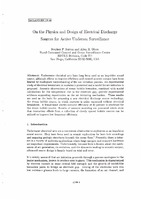| dc.contributor.author | Sutton, Stephen P. | |
| dc.contributor.author | Olson, Allen H. | |
| dc.date.accessioned | 2018-10-11T14:08:41Z | |
| dc.date.available | 2018-10-11T14:08:41Z | |
| dc.date.issued | 1993/08 | |
| dc.identifier | 11924 | |
| dc.identifier.govdoc | CP-42/2 | |
| dc.identifier.uri | http://hdl.handle.net/20.500.12489/500 | |
| dc.description.abstract | Underwater electrical arcs have long been used as an impulsive sound source, although efforts to improve efficiency and control acoustic output have been limited by inadequate understanding of the arc initiation process. An experimental study of electrical breakdown in seawater is presented and a model for arc initiation is proposed. Acoustic observations of steam bubble formation, combined with model calculations for the temperature rise in the electrode gap, provide experimental evidence supporting vaporization as the arc initiating mechanism. These results are used as the basis for proposing a new electrical discharge source technology, the steam bubble source, in which seawater is pulse vaporized without electrical breakdown. A broad-band electro-acoustic efficiency of 30 percent is predicted for the steam bubble source. Results of acoustic modeling are presented which show that interaction effects from a collection of closely spaced bubble sources can be utilized to improve low frequen cy efficiency. | |
| dc.format | 16 p. : ill., 8 fig. ; digital, PDF file | |
| dc.language | English | |
| dc.publisher | NATO. SACLANTCEN | |
| dc.source | In: Low frequency active sonar (SACLANTCEN Conference Proceedings CP-42), vol. 2, 1993, pp. J/29-1 - J/29-16. | |
| dc.subject | Underwater electrical arcs | |
| dc.subject | Bubbles | |
| dc.subject | Underwater surveillance | |
| dc.subject | Low Frequency Active Sonar (LFAS) | |
| dc.subject | Low frequency acoustics | |
| dc.subject | Electroacoustics | |
| dc.title | On the physics and design of electrical discharge sources for active undersea surveillance | |
| dc.type | Papers and Articles | |
| dc.type | Conference Proceedings (CP) | |
